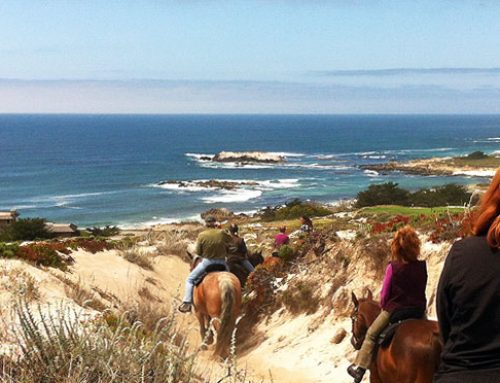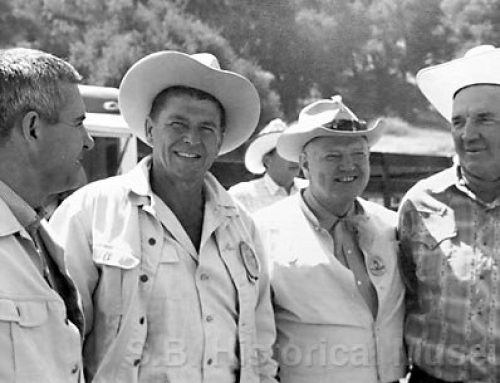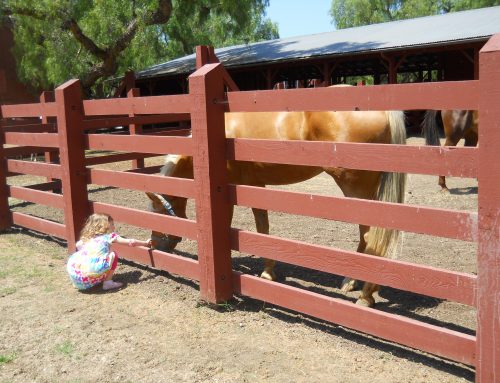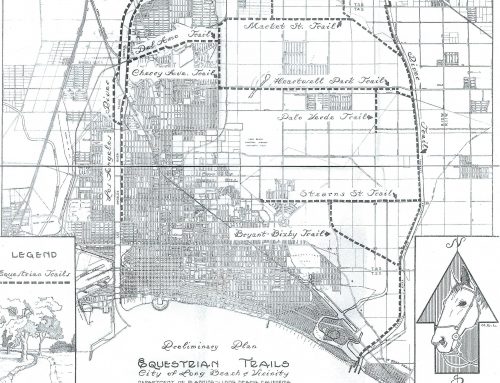
A RIDER AT THE CHILDREN’S RANCH FOUNDATION
Development Along the L.A. River Could Snuff Out Some of L.A.’s Last Horse Ranches
A community battle is brewing in Atwater Village
Verdant Street is easy to miss, but the private, nondescript road off Brunswick Avenue leads to one of L.A.’s most historic locales: an agricultural pocket of Atwater Village between the Forest Lawn cemeteries that’s dotted with stables and home to an estimated 400 horses. The so-called equestrian district has ranchoroots that stretch back to the 1700s; it was once part of Rancho San Rafael, a large land parcel that stretched across much of what is now northeast Los Angeles.
Today some residents believe the area’s future is at risk. Real estate developer and philanthropist Morton La Kretz, who is an advisory member of the L.A. River Revitalization Corporation, is looking to build 60 townhomes at 4000 Chevy Chase Drive, a nearly 3-acre lot that has for decades served as a buffer between seven barn properties and the charming neighborhood that surrounds them. The new homes would range from 1,400 square feet to 1,700 square feet in size. A warehouse that currently holds movie scenery and was once a wallpaper factory would need to be demolished and a significant zoning change would need to be approved to make way for the project.

This factory could be demolished to make way for 60 townhomes
The prospect has stable owners and local stakeholders, including the Los Angeles Equine Advisory Committee and the Atwater Village Neighborhood Council, concerned they’ll lose safe and easy access to two nearby trails—the Los Angeles River Equestrian Trail, which snakes along the river to Los Feliz Boulevard, and the Juan Bautista de Anza National Historic Trail.

The view to the north from the Los Angeles River Equestrian Trial
One such stakeholder, The Children’s Ranch Foundation director Jackie Sloan—who has run therapeutic equestrian programs for children with special needs at her property since 2006—is pushing back. She’s written three letters to the Department of City Planning since May and has organized a new community group, Atwater Village Always, that’s hired an attorney to forestall major changes to the district. Instead of a full environmental report, developers were allowed to submit an expedient Mitigated Negative Declaration, which is expected to be made public shortly. AVA is preparing its response. La Kretz has not responded to a request from Los Angeles for comment.
“There are people,” says Sloan, “who feel the L.A. River Revitalization Corporation has gotten a more focused on housing and retail than recreation along the river.”
We asked her to fill us in:
You’ve owned The Children’s Ranch Foundation since 2003. Do you remember what you thought when you visited Atwater Village for the first time?
I could not believe there could be horses right in the middle of the city—and with access to a river trail! It was like a little slice of heaven, horse heaven. For our program especially, and [nearby riding non-profit] Taking the Reigns, the fact that it’s not out in the suburbs an hour away means our clients can actually come here. We can serve Central L.A. and East L.A. and Mid-City. There are really fabulous equine intervention programs for kids and teens way out, but transportation is such an issue.
Tell me about the Children’s Ranch Foundation programs. How do they work?
Kids who are motivated by animals have a reason to manage their behavior, because they don’t want to scare the horse or the rabbit or the chicken that they care about. The program gives these kids a motivation to communicate, even non-verbally, with a horse. There’s a conversation back-and-forth between horse and rider that isn’t all based on language. Also, being around a large animal can be quite relaxing and centering for some people, although not all.
How does the proposed development threaten your business?
There was nothing stated in the plan about interface with the equestrian community. Since we’ve voiced our deep, deep worries, at some of the neighborhood council meetings and other meetings, a representative for the developer has said, “We love horses and would never want to hurt them.” I believe them, but it’s so unexpected how much [space] horses need. Before I was involved with horses I couldn’t have guessed that. I would have said, “Put up a wall and you do one thing on one side and I’ll do something on the other,” but the proximity [between parcels] is very close. If what’s now a bridle path becomes a walking path and there are 60 families with dogs and bikes and everything—
Do the barn owners need easy access to the river?
We have to be able to access the river to exercise our horses and to be able to ride them safely. They can’t just use one small, hot arena. For therapeutic reasons, being able to ride the horses in a straight line is very important to [the Children’s Ranch]. It’s difficult to maintain your core balance in a circle. We need to give our clients relief to be able to go in a straight line and relief from the sun. Having that shady, tree-lined path down the river is critical to being able to keep the kids safely on the horses.
As our vet was explained to us, horses are so sensitive, especially our therapeutic horses that are really elderly. Just the dust and toxins from blowing up that building or however they have to take it down really could pose a health threat. Certainly I couldn’t have kids doing programs during that time. And the noise is very difficult for horses to deal with. We would have to relocate during that time.
What would you like to see the developer do with the property instead of building dozens of townhomes?
What they’re currently zoned for—that could be one option. There’s a pretty vibrant community along San Fernando Road that’s turning warehouses into artists lofts and that old Van Luit wallpaper factory has some seemingly useful roll-up doors that could be repurposed [for that]. I dream of having a river community center there, something that keeps density down but celebrates the equestrian district.
Is there another compromise that’s livable? What are your must-haves?
Safe access to what’s already here [for the horses] and some kind of insurance that any zoning changes don’t spread to the rest of the equestrian district.
The overarching fear of residents and equestrians is that once a zoning change is obtained and once the General Plan of the City of Los Angeles is amended to allow this development on what’s now zoned Agricultural and Low Residential, it could become precedent. What about the property next door? And the next one? These properties are big. They look desirable to developers who want to build housing. The real question for L.A. is, As we develop the river, are we invested in keeping one teeny, tiny historic equestrian district intact as the jewel of the river? If the answer is yes, we need a buffer zone. It can’t be right up against density.
What do you think will happen if the plans go through without modifications?
If we can’t ride safely here, we can’t have a program here. The families we serve will have to go and find something horse-related in the suburbs. But what we do is somewhat unique. Other programs are more focused on the physical benefits of riding—posture, stability, fine motor and sensory integration. There aren’t a lot of programs focused on social-emotional connections and helping parents find tools that are useful in both the riding context and at home or school. I think it would be devastating. I’ve had families say, ‘Please don’t tell me you’re leaving. I can’t hear that.’
You’re not the only stable owner fighting to keep the district as is. How have you been garnering support?
We’ve been going door to door, delivering invitations to come and talk. On Mother’s Day we had a meeting and then from there it feels like we’ve had meetings almost every day. [Ranch supporters] went as a group to Los Angeles River Day to understand how we fit in and meet some of our council members. We’ve been going to all of the Atwater Village Neighborhood Council meetings and river committee meetings.
Does the coalition you’ve built include all of the stable owners in the area?
All the other barns—everyone is going to everything. We haven’t had anyone stand back, unless for the reason that they can’t get involved, like the LAPD. [The department’s Mounted Platoon, which uses one of the area’s seven stables, is reportedly prohibited from participating in political action.]
How are you feeling now about the equestrian district’s future?
Optimistic. We had a groundswell of support at our latest meeting. People came, then went home to get checkbooks and come back. We raised $15,000 from people of very modest and average means, all of them neighbors. We’ll use that money to hire consultants and get appropriate legal guidance.
Has there been a silver lining to this experience?
People are starting to understand that if they don’t get involved, they’re going to lose the reason they moved to the neighborhood. People who don’t have horses want to take a walk next to horses. They’re proud to live in the last bastion of equine property. I feel very positive because I believe that with this support we will be able to reach the developer and have a reasoned conversation. I think they haven’t thought of these issues. We just need to get together and take a walk. The La Kretzes are huge philanthropists. They’ve supported programs for children and UCLA and the environment. I don’t think anything they do is a bottom-line issue. They just need to talk to us.
If you had two minutes with them today, what would you say?
I would say: “Be the developer that saved Los Angeles’ equestrian presence along the river.”
Copyright goes to Los Angeles Magazine ©LosAngelesMagazine2015
Published article here http://www.lamag.com/citythinkblog/development-along-the-l-a-river-could-snuff-out-some-of-l-a-s-last-horse-ranches/















Leave A Comment